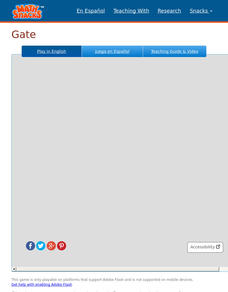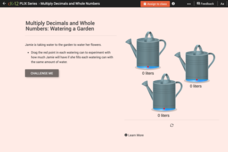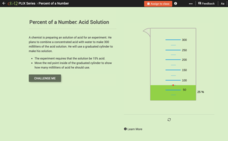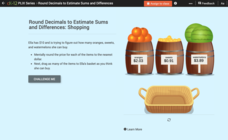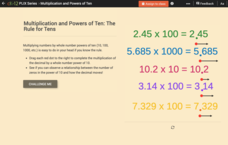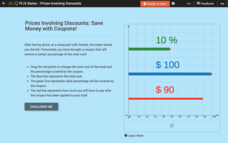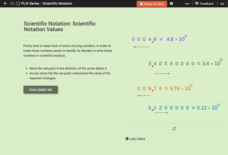Arcademics
Hungry Puppies
It all comes down to the treats. Individuals compete to find decimals' addends to arrive at a given sum. Pupils click on two dog treats with values that add to the target number. Each round contains the same sum and lasts a minute, and...
New Mexico State University
Gate
Build numbers with place value to save the day. Pupils use the keyboard to control the digits in the hundredths through hundreds place to create target numbers to destroy shadows. As participants build the numbers, a number line shows...
CK-12 Foundation
CK-12 Middle School Math Concepts - Grade 6
Twelve chapters cover a multitude of math concepts found in the Common Core standards for sixth grade. Each title provides a brief explanation of what you will find inside the chapter—concepts from which you can click on and learn more...
CK-12 Foundation
Add and Subtract Decimals with Front-End Estimation: Wooden Beams
A six-question interactive tasks mathematicians to solve addition and subtraction problems using front-end estimation. Question types consist of multiple-choice and true or false. A set of wooden beams that can be measured using moveable...
CK-12 Foundation
Estimation to Check Decimal Multiplication: Watering a Garden
Mathematicians solve six multiple-choice and true or false questions using their knowledge of estimation and multiplying decimals. The interactive provides a garden-themed tool that creates a visual aid of three watering cans to assist...
CK-12 Foundation
Values Written as Powers: Binary Numbers 1 to 8
A six-question interactive tasks scholars with adding binary numbers one through eight. A tool acts as a visual aid to showcase the patterns made when working with base—2, digits zero and one. Question types include fill in the blank,...
CK-12 Foundation
Conversion of Decimals, Fractions, and Percents
Five questions—true or false and multiple-choice—challenge mathematicians to convert decimals, fractions, and percents. An interactive table displays how to write a portion of shapes in a variety of ways. A discussion question concludes...
CK-12 Foundation
Percent of a Number: Acid Solution
Mathematicians answer five questions about percents, ratios, and proportions with help from an interactive graduated cylinder. Question types include multiple-choice, fill-in-the-blank, and discussion.
CK-12 Foundation
Problem Solving Plan, Estimation with Decimals: Shopping
Mathematicians go on a virtual shopping trip in an interactive designed to boost the concept of estimation. Scholars read and answer five questions—multiple-choice, true or false, and a discussion—with help from a drag-and-drop shopping...
CK-12 Foundation
Comparison of Fractions, Decimals, and Percents: Filling in the Squares
An interactive equipped with five questions challenges mathematicians to convert between fractions, decimals, and percents. A diagram changes its size to visually depict conversions alongside symbols to compare them. Question types...
CK-12 Foundation
Mental Math to Divide by Whole Number Powers of Ten: Mental Math to Divide Decimal Powers of Ten
Boost mental-math skills with an interactive that focuses on dividing whole numbers by powers of 10. Mathematicians solve five fill-in-the-blank and multiple-choice questions with help from a moveable decimal point in four example...
CK-12 Foundation
Mental Math to Multiply by Whole Number Powers of Ten: The Rule for Tens
Eight questions challenge scholars to use mental math while multiplying whole numbers by powers of 10. A tool with bouncing decimals demonstrates how and where the decimal moves. Question types include several multiple-choice, a...
CK-12 Foundation
Mental Math to Divide by Whole Number Powers of Ten: Bouncing Decimal Point
Five questions challenge mathematicians to divide whole numbers by powers of 10. A tool highlights how a bouncing decimal moves through the divisor. Question types include multiple choice and fill in the blank. A discussion question...
EngageNY
Grade 5 Math Module 1: Mid-Module Assessment
Show the knowledge learned about decimals. A short assessment covers the material presented in the first half of the unit. Pupils demonstrate their knowledge of comparing, rounding, and multiplying and dividing by powers of 10 with...
EngageNY
Grade 5 Math Module 1, Topic F, Lesson 15
Remainders don't need to remain a mystery. The 16th of 18 parts in Grade 5 Math Module 1 continues the study of dividing decimals by a whole number. Scholars see how to rename the remainder to a smaller unit, such as when dividing 1.7 or...
EngageNY
Grade 5 Math Module 1, Topic F, Lesson 14
Be sure to place value on place value understanding. Young mathematicians learn to divide decimals by whole numbers when compatible numbers are not available. They use place value discs in place value charts, then connect this strategy...
EngageNY
Grade 5 Math Module 1, Topic F, Lesson 13
After completing a fluency practice set on subtracting, multiplying, and comparing decimals, pupils begin learning about dividing decimals by whole numbers. They see how to use place value reasoning to find compatible numbers for...
EngageNY
Grade 5 Math Module 1, Topic C, Lesson 7
Step up or step down to rounding. Using a vertical number line, the lesson shows pupils the significance of rounding up or rounding down. Teachers encourage scholars to write the number in unit form and decide which form helped the most...
CK-12 Foundation
Prices Involving Discounts: Save Money with Coupons!
Nine questions make up an interactive that challenges scholars to identify new prices after discounts. Question types include fill in the blank and multiple choice. A fully-functional tool assists participants in solving word problems....
CK-12 Foundation
Properties of Multiplication in Decimal Operations: Balloon Animals
Commutive and associative properties are the focus of a five-question interactive. Dealing with decimal multiplication and addition, mathematicians solve multiple-choice and true or false questions using a model that moves balloons along...
CK-12 Foundation
Decimal Rounding Given Place Value
Tests mathematicians' knowledge of decimals, place value, and rounding with a five-question interactive. A tool with movable parts assists scholars in answering questions—multiple-choice and true or false. A discussion question...
CK-12 Foundation
Repeating Decimals: Does 1 equal 0.999... ?
Six questions make up a challenging interactive that tests scholars' knowledge of repeating decimals. Mathematicians answer true or false and multiple-choice questions with help from a tool that highlights decimal movement in an...
CK-12 Foundation
Scientific Notation Values
Scientific notation is the focus of a five-question interactive. A model with movable points offers a visual reference to help solve true or false, multiple-choice, and fill in the blank questions. A discussion question challenges...
CK-12 Foundation
Numbers with Decimal Place Value: Battleship Decimals
Decimal place value is the topic of a Battleship themed-interactive. Scholars answer five questions—multiple-choice and true or false—while referencing a grid that acts as the board game. The practice concludes with a discussion question.



